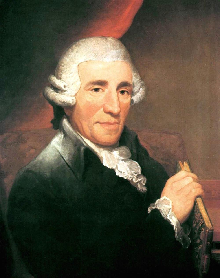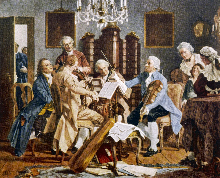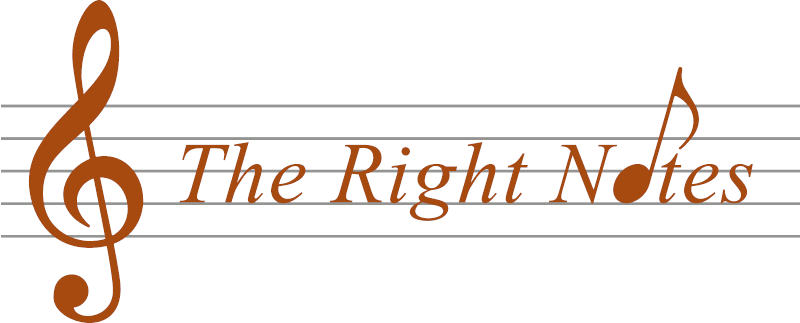Haydn's humour
When I read recently that Franz Joseph Haydn was a composer you learn to appreciate more with age, I decided he’d be an ideal subject for one of these get-togethers.
But given that he wrote 108 symphonies (some say 104), more than 80 string quartets, over 50 piano sonatas, at least 24 concerti, 20 operas and goodness knows how many chamber and choral works, I decided I would have to come up with a theme.

When he was a boy Joseph Haydn and his brother Michael were choirboys at St Stephen’s Cathedral in Vienna. Michael sang beautifully but as for Joseph, well, after his voice broke Queen Maria Theresa – more of whom later – complained that he “sang like a crow”.
He was subsequently dismissed from the choir, most probably because of his voice but possibly also because he cut off the pigtail of a fellow chorister – a prank for which he was caned.
This pigtail-cutting reflected one of Haydn’s great traits – a mischievous sense of humour. And it’s Haydn’s humour that’s the subject of today’s programme.
We’ll start in a obvious place – with the fourth movement of Haydn’s String Quartet No.30 in E-Flat Major, Opus 33 No. 2 – otherwise known as ‘The Joke’, written in 1781.
The story goes that Haydn wrote the ending to win a bet that “the ladies will always begin talking” before the music stops. And so the finale can be strangely disorientating and confusing with a whole series of false endings, weird pauses and wrong places to clap. Clara Schumann wrote of how she laughed aloud after hearing a performance. I bet nobody here laughs at this.
By the way, when this piece does finally end it seems to do so by no musical logic other than that it has stopped.
Mozart said that Haydn could “amuse and shock, arouse laughter and deep emotion as no-one else”, but we’ll concentrate on the “amuse” bit this morning. That said, I’m not sure if anyone here will necessarily be amused, although I and sure you will at least smile at least once.
I find the humour in Haydn’s music a bit obscure. I was born at the wrong time, and with the wrong kind of brain, to find anything worth a laugh in Charlie Chaplain films, and the same goes for the music by Haydn that he thought humorous.
Here’s an example of that. You are going to hear an early Haydn work, his Capriccio in G Major, written in 1765. It takes as its theme an old Austrian folk song, Acht Sauschneider Müssen Sein, which describes castrating a boar, an operation for which eight expert butchers were apparently needed.
“It takes eight of you to castrate a boar - two in front, two behind, two to cut, two to bind....” Haydn translates this into musical terms in this ‘theme-and-variations’ piece by wandering wildly from one key to the next.
By the way, I have something more to tell you about castration. As I said earlier, before his voice broke, Haydn was a great singer. So when his choirmaster suggested that if he had a small operation he would be able to keep his unbroken voice for the rest of his life, he liked to sound of the idea.
It was only when his horrified father discovered that his son was about to go under the surgeon’s knife that Haydn was told what the operation actually involved. He chickened out.
Anyway, here is Haydn’s _Capriccio in G Majo_r.
As I said earlier, don’t expect a bundle of laughs today. Just enjoy the music. We’ll now hear part of a Haydn symphony – No. 47 in G Major. Many of Haydn’s symphonies had nicknames: The Philosopher, The Bear, The Schoolmaster, The London, and so on.
This one is called The Palindrome because, with typical Haydn humour, the second part of the minuet is exactly the same as the first but backwords. You will have to take my word for it. Have some fun with the YouTube recording.
Someone once told me that she liked the sound of an orchestra tuning their instruments before a concert. She might like this piece.
Haydn’s Symphony No. 60 is nicknamed ‘Il Distratto’, The Distracted Gentleman. The finale features one of Haydn’s best-known musical jokes. The energetic opening grinds to a sudden halt followed by a spectacularly discordant orchestral flourish as the violins discover that they seemingly need to retune their strings – which they noisily do for 10 10 15 seconds before the resume playing.
I hope that by now you realise by now that this programme, with its theme of humour, is just a construct to play some music by Haydn, a composer sometimes thought of as a poor man’s Mozart. I think the comparison is unfair. He created a new medium, the string quartet.

There had been classical music for four players before Haydn but he established a genre in which each instrument was equal and independent. And though he didn’t invent the symphony he is frequently referred to as the “father of the symphony”.
In the fourth movement of his Quartet No. 1, Opus 50, written in 1787, Haydn uses his old joke, a real rib-tickler this one, of false conclusions, as you will hear from this recording, which goes at a fair lick.
Symphony No. 101, ‘The Clock’, is one of Haydn’s best known and it has its nickname because of the ticking rhythm throughout the second movement. There’s nothing monotonous about this ticking though. As someone said: “Haydn has a gratifying number of different clocks in his shop, offering ‘tick-tock’ in a happy variety of colours.
In 1793, Haydn had given his employer Prince Esterházy an elaborate musical clock, for which he wrote 12 short pieces, one of them being the basis for the third movement. This movement, a minuet, is one of Haydn's longest and in it Haydn, with typical humour, seeks to evoke a bungling village band.
So, let’s hear both these movements, the second, which gave the symphony its nickname, and the third movement with its sleepy village band with its relentless hurdy-gurdy drones and a naïve flute solo.
‘The Clock’, by the way, is the ninth of the 12 so-called London Symphonies by Haydn.
Haydn was born in 1732 in a village on the Austrian border with Hungary. His father was the village mayor and his mother a cook in the palace of a local aristocrat. He himself came to be closely associated with Austrian aristocracy. Haydn spent much of his career as a court musician for the wealthy Esterházy family at their remote estate.
Until the later part of his life, this isolated him from other composers and trends in music so that he was, as he put it, "forced to become original". Yet his music circulated widely, and for much of his career he was the most celebrated composer in Europe, a friend and mentor of Mozart and a tutor of Beethoven. ‘Papa Haydn’, they called him.
More music now. Haydn’s Fantasia in C Major is one of his most virtuosic piano works. Written in 1789, in what Haydn called a “whimsical hour”, it features something he intended as a joke of sorts. Twice in the score he wrote, in Italian, “Hold until the sound is not heard any more”. It’s something that surprised and amused Haydn’s audiences. Has the poor pianist had an unfortunate memory lapse?
But maybe there’s another Haydn joke in this piece. In a letter to his publisher he wrote: "In a moment of great good humour I have completed a new Capriccio for fortepiano, whose taste, singularity and special construction cannot fail to receive approval from connoisseurs and amateurs alike. A single movement, rather long, but not particularly difficult." The joke is that it was soon found to be anything but easy to play.
By the way, Haydn found the main melody for this piece in a folk song, The Farmer’s Wife has lost her Cat.
The Farewell Symphony, No. 45, is another example of how Haydn incorporated his sense of humour into his compositions.
Haydn wrote the symphony in 1772. At that time, his patron Nikolaus I, Prince Esterházy was resident, together with all his musicians and retinue, at his favourite summer palace in rural Hungary. The stay there had been longer than expected, and most of the musicians had been forced to leave their wives back at home in Eisenstadt, about a day's journey away.
Longing to return, the musicians appealed to their Kapellmeister, Haydn, for help. However, being diplomatic Haydn decided that instead of making a direct appeal on the musicians’ behalf, he would put his request into the music of the symphony.
And so during the final adagio each musician stops playing, snuffs out the candle on his music stand, and leaves in turn, so that at the end, there are just two muted violins left (played by Haydn himself and his concertmaster, Luigi Tomasini).
The prince seems to have understood the message: the court returned to Eisenstadt the day after the performance.
And so to this day whenever this symphony is performed the final movement sees the musicians stand up, some of them playing little solo pieces first, and leave the stage one by one, until only a pair of violins remain. Because of this, it’s very often the last piece played before the interval.
Obviously, Haydn determined the order of departure: first oboe and second horn, then bassoon, second oboe and first horn, then double bass, cello, most of the violins, and then violas. As the number of remaining instruments dwindles, the sound emanating from the orchestra gradually becomes audibly thinner. The first chair violinists remain to complete the work. The ending is a kind of deliberate anti-climax and is usually performed as a very soft pianissimo.
By the way, this symphony is in F sharp minor, and is thought to be the only 18th century symphony written in that key – another example of Haydn being innovative. Let’s hear the finale.
Life changed for Haydn in 1779, when his contract with Prince Esterhazy was renegotiated. It meant that his new compositions were no longer the property of the Esterhazy family. He could now write for others and sell his work. This meant more symphonies and quartets and fewer operas. And it resulted in his career taking a huge step forward, leading to him being recognised as Europe’s pre-eminent composer.
Haydn started to travel abroad and when his boss Prince Nikolaus Esterhazy died his son Anton dismissed most of his court musicians and had little use of Haydn’s services. Haydn went to London, where his music was dominating the concert scene. Before he crossed the English Channel, and it was the first time he had seen the sea, he said goodbye to Mozart.
The two composers had met for the first time around 1784 and it’s thought they played in string quartets together. They certainly became good friends and hugely admitted each other’s work.
It’s time we had more humour. One of Haydn’s big jokes was the Surprise Symphony, Symphony No. 94, which he wrote during one of his two stays in London. Haydn found that the English tended to have a good meal before going to a concert, and probably drank a bit too much as well. This resulted in half the audience nodding off in quieter moments of a composition.
And so the symphony’s slow movement gets off to a beautifully quiet start, cares start to fall away and folk begin to doze off. We are lulled into a trance and then, bang, the timpani crashes in, leaving half the audience wondering how they can retrieve their powdered wigs which fell off when they woke up with a start.
There’s a good story about Haydn’s Violin Sonata in E-Flat Major. It’s in two movements and the second, an allegro, carries the sub-title Jacob’s Dream – an allusion to Jacob’s dream of a ladder stretching up to heaven.
The story is that the violinist of the trio that gave the first performance was particularly arrogant and vain. The first part of the music is fairly simple and can be sightread.
However, after the page-turn the fiddle part somewhat escapes into new heights, designed by Haydn to give this pompous musician some serious difficulties and to teach him a lesson in humility.
Let’s hear it now.
I mentioned Haydn’s friendship with Mozart but he had a different relationship with Beethoven, who was to become Haydn’s pupil. When he was 20 Beethoven showed Haydn some of his scores and Haydn was so impressed that he offered to take the young composer under his wing. However, Beethoven found that his new mentor didn’t give him the time he felt he deserved and secretly took lessons with other teachers.
Let’s quickly go back to some music and Haydn’s favourite joke – confusing the audience as to when a piece ends.
In the finale of his _Symphony No 90 _there is an uncomfortable silence which leads the audience to believe it’s time to applaud. Haydn thought this was great fun. Here it is…
By the beginning of the 19th century Haydn’s health was failing. He was 68 and struggled to complete works. By the end of 1803, his condition had declined to the point that he became physically unable to compose. He suffered from weakness, dizziness, inability to concentrate and painfully swollen legs. It’s now thought that he had arteriosclerosis.
He had staff to care for him in his last few years and he died, aged 77, in Vienna in May 1809.
The timing is significant in that it coincided with the French Army under Napoleon attacking the city. Indeed, the French bombardment of the city rattled the doors and windows of his hose. Just a few days before Haydn passed away a French officer visited his house to pay his respects and sang to him an aria from his The Creation.
So, let me tell you a bit about The Creation, one of his great masterpieces. Completed in 1798, it’s an oratorio that celebrates the creation of the world according to the Book of Genesis, the Book of Psalms and Milton’s Paradise Lost. Haydn considered it his greatest achievement.
The Creation is in three parts, the second of which alludes to the creation of man, woman and animals. Saint-Saens’ Carnival of the Animals it is not but Haydn does use trombones and contrabassoon to depict the roar of a lion but there’s also reference to frolicking stags, cattle and sheep, and a swarm of bees represented by the strings. There’s even a worm, represented by low notes sung by the bass soloist and well as a motive that could be described as a worm moving. Haydn’s wee joke is that the smallest creature gets the longest and most drawn-out introduction.
So, let’s hear the section called Strait Opening her Fertile Womb from Part 2 of The Creation. You should know that Haydn particularly wanted The Creation to be sung in either German or English.
I want to stick with The Creation for a few minutes and play something that’s no joke at all: the opening. Haydn is particularly clever in this part of the work, which he called The Representation of Chaos. The be able to convey the story without text he met the British astronomer William Herschel to learn how, Herschel believed, the cosmos was formed.
He later observed that in this music he “avoided the resolutions that you would most readily expect. The reason is that there is no form in anything in the universe yet.”
So let’s hear the formless The Representation of Chaos.
I must finish now and use a word I would never use in polite company. And so I’m going to use it here. The word is “fart”, and it’s the only word that’s ever used in relation to a particularly cheeky bit of music by Haydn.
The third of his London Symphonies was most probably Symphony No. 93, which was completed in 1791. In the second movement, the music begins very sedately and becomes slower and softer. And then the bassoon, well, farts rather unexpectedly.
The conductor George Szell as particularly keen not to underplay what he called “the vulgarity of this joke”. It’s been argued that if no-one in the audience laughs at this point the episode was seriously underplayed.
In choosing this recording I have listened to more of Haydn’s farts than I would want to but I think here George Szell deals with the key moment appropriately. You may, or may not, consider it worth the wait.
Featured composers:
Featured genres:
Haydn's humour playlist
Each Spotify track has been chosen specifically; however, the corresponding YouTube videos may be performed by different orchestras.
